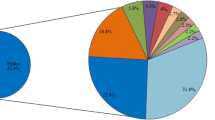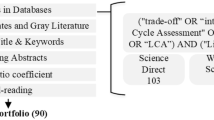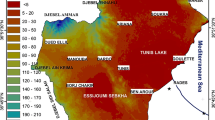Abstract
Goal programming models offer an analytical framework to study multi-criteria problems involving several conflicting objectives. Real world problems often involve imprecise information, which makes fuzzy goal programming (FGP) models the most attractive choice. In this paper, we propose an FGP model that integrates optimal resource allocation to simultaneously satisfy prospective goals on economic development, energy consumption, workforce, and greenhouse gas emission reduction applied to key economic sectors of the United Arab Emirates. The model offers valuable insights to decision makers for strategic planning and investment allocations towards sustainable development. We demonstrate the validity and applicability of the model through a numerical example.


Similar content being viewed by others
References
Agrawal, R. K., & Singh, S. P. (2001). Energy allocation for cooking in UP household (india) a fuzzy multi-objective analysis. Energy Conversion and Management, 42, 2139–2154.
AlFarra, H. J., & Abu-Hijleh, B. (2012). The potential role of nuclear energy in mitigating \({\text{ CO }_{2}}\) emissions in the United Arab Emirates. Energy Policy, 42, 272–285.
Al-mulali, U., & Binti Che Sab, C. N. (2012). The impact of energy consumption and \({\text{ CO }_{2}}\) emission on the economic and financial development in 19 selected countries. Renewable and Sustainable Energy Reviews, 16(7), 4365–4369.
André, F. J., Cardenete, M. A., & Romero, C. (2009). A goal programming approach for a joint design of macroeconomic and environmental policies: A methodological proposal and an application to the Spanish economy. Environmental Management, 43, 888–898.
Aouni, B., & La Torre, D. (2010). A generalized stochastic goal programming model. Applied Mathematics and Computation, 215, 4347–4357.
Aouni, B., Colapinto, C., & La Torre, D. (2013). A cardinality constrained stochastic goal programming model with satisfaction functions for venture capital investment decision making. Annals of Operations Research, 205(1), 77–88.
Aouni, B., Colapinto, C., & La Torre, D. (2014). Portfolio management through goal programming: State-of-the-art. European Journal of Operations Research, 234, 536–545.
Arnette, A., & Zobel, C. W. (2012). An optimization model for regional renewable energy development: Review article. Renewable and Sustainable Energy Reviews, 16(7), 4606–4615.
Balaman, Ş. Y., & Selim, H. (2014a). Multiobjective optimization of biomass to energy supply chains in an uncertain environment. Computer Aided Chemical Engineering, 33, 1267–1272.
Balaman, Ş. Y., & Selim, H. (2014b). A fuzzy multiobjective linear programming model for design and management of anaerobic digestion based bioenergy supply chains. Energy, 74, 928–940.
Bellman, R. E., & Zadeh, L. A. (1970). Decision making in a fuzzy environment. Management Sciences, 17, B141–B164.
Bilbao-Terol, A., Arenas-Parra, M., & Cañal-Fernández, V. (2012). A fuzzy multi-objective approach for sustainable investments. Expert Systems with Applications, 39(12), 10904–10915.
Borges, A. R., & Antunes, C. H. (2003). A fuzzy multiple objective decision support model for energy-economy planning. European Journal of Operational Research, 145, 304–316.
Charnes, A., & Cooper, W. W. (1952). Chance constraints and normal deviates. Journal of the American Statistical Association, 57, 134–148.
Charnes, A., Cooper, W. W., & Ferguson, R. (1955). Optimal estimation of executive compensation by linear programming. Management Science, 1, 138–151.
Charnes, A., & Cooper, W. W. (1959). Chance-constrained programming. Management Science, 6, 73–80.
Charnes, A., Copper, W. W. (1961). Management models and Industrial applications of linear programming. New York: John Wiley & Sons Inc.
Daim, T. U., Kayakutlu, G., & Cowan, K. (2010). Developing Oregon’s renewable energy portfolio using fuzzy goal programming model. Computers and Industrial Engineering, 59, 786–793.
DeFelice, N. B., & Gibson, J. M. (2013). Effect of domestic water use on air pollutant emissions in Abu Dhabi, United Arab Emirates. International Journal of Energy and Environmental Engineering, 4(1), 33.
Ghosh, S., Basu, S. C., & Sengupta, P. P. (2010). Improvement of financial efficiency and cost effectiveness in energy sector: A case study from Indian thermal power plant. In ICEMT 2010–2010 international conference on education and management technology proceedings (pp. 512–516).
Han, J.-H., Ahn, Y.-C., & Lee, I.-B. (2012). A multi-objective optimization model for sustainable electricity generation and CO\(_{2}\) mitigation (EGCM) infrastructure design considering economic profit and financial risk. Applied Energy, 95, 186–195.
International Energy Agency. (2011). Retrieved online http://www.iea.org/statistics/statisticssearch/report/?country=UAE&product=electricityandheat&year=2011
Jayaraman, R., La Torre, D., Malik, T., & Pearson, Y. E. (2015). A polynomial goal programming model with application to energy consumption and emissions in United Arab Emirates. In Proceedings of 2015 international conference on industrial engineering and operations management. IEEE xplore. ISBN: 978-0-9855497-2-5.
Jinturkar, A. M., & Deshmukh, S. S. (2011a). A fuzzy mixed integer goal programming approach for cooking and heating energy planning in rural India. Expert Systems with Applications, 38(9), 11377–11381.
Jinturkar, A. M., & Deshmukh, S. S. (2011b). Optimization of energy resources for cooking and heating-A fuzzy goal programming approach. Journal of Renewable and Sustainable Energy, 3(4), 043117.
Jones, D., & Tamiz, M. (2010). Case study—Aplication of goal programming in portfolio selection. Practical goal programming, International series in operations research & management science: Springer.
Kazemi, A., Mehregan, M. R., & Shakouri, H. (2011). Energy supply model for Iran with an emphasis on greenhouse gas reduction. In Proceedings of the 41st international conference on computers & industrial engineering (pp. 491–496).
Kazim, A. M. (2007). Assessments of primary energy consumption and its environmental consequences in the United Arab Emirates. Renewable and Sustainable Energy Reviews, 11(3), 426–446.
Kiker, G., Kiker, A., Bridges, T. S., Varghese, A., Seager, T. P., & Linkov, I. (2005). Application of Multicriteria Decision Analysis in Environmental Decision Making. Integrated Environmental Assessment and Management, 1(2), 95–108.
Labor Migration in UAE. (2013). Retrieved online, URL: http://www.migrationpolicy.org/article/labor-migration-united-arab-emirates-challenges-and-responses
Lee, S. M. (1973). Goal programming for decision analysis of multiple objectives. Sloan Management Review, 14, 11–24.
Lee, C. F., Lin, S. J., Lewis, C., & Chang, Y. F. (2007). Effects of carbon taxes on different industries by fuzzy goal programming: A case study of the petrochemical-related industries. Taiwan, Energy Policy, 35(8), 4051–4058.
Lee, C. F., Lin, S. J., & Lewis, C. (2008). Analysis of the impacts of combining carbon taxation and emission trading on different industry sectors. Energy Policy, 36(2), 722–729.
Lee, S. M., Nicely, R. (1974). Goal programming for marketing decisions: A care study. The Journal of Marketing, 38(1), 24–32.
Mezher, T., Chedid, R., & Zahabi, W. (1998). Energy resource allocation using multi-objective goal programming: The case of Lebanon. Applied Energy, 61(4), 175–192.
Mokri, A., Aal Ali, M., & Emziane, M. (2013). Solar energy in the United Arab Emirates: A review. Renewable and Sustainable Energy Reviews, 28, 340–375.
Narayanan, B. G., Aguiar, A., & McDougall, R. (2012). Global trade, assistance, and production: The GTAP 8 data base. Center for global trade analysis, Purdue University.
Narsimhan, R. (1980). Goal programming in a fuzzy environment. Decision Sciences, 11, 325–336.
Omri, A. (2013). CO\(_{2}\), emissions, energy consumption and economic growth nexus in MENA countries: Evidence from simultaneous equations models. Energy Economics, 40, 657–664.
Pal, B. B., & Kumar, M. (2013). Interval goal programming for economic–environmental power generation: Dispatch problems. In IEEE international conference on fuzzy systems 2013 (p. 6622446).
Ramathan, R., & Ganesh, L. S. (1995a). Energy resource allocation incorporating qualitative and quantitative criteria: An integrated model using goal programming and AHP. Socio-Economic Planning, 29(3), 197–218.
Ramathan, R., & Ganesh, L. S. (1995b). Energy alternatives for lighting in households: An evaluation using an integrated goal programming-AHP model. Energy, 20(1), 63–72.
Romero, C. (1991). Handbook of critical issues in goal programming. Elmsford: Pergamon.
Sadeghi, M., & Hosseini, H. M. (2006). Energy supply planning in Iran by using fuzzy linear programming approach (regarding uncertainties of investment costs). Energy Policy, 34, 993–1003.
UAE Ministry of Economy-Annual Economic Report. (2012). Retrieved online: http://www.economy.ae/English/Documents/Annual%20Economic%20Report%202012-en.pdf
UAE National Bureau of Statistics. (2011). URL: http://www.uaestatistics.gov.ae/EnglishHome/CensusEN/
UAE Vision 2021. Retrieved online URL: http://www.vision2021.ae/en
United Nations Framework Convention on Climate Change. (2012). Retrieved online: http://unfccc.int/national_reports/non-annex_i_natcom/items/2979.php
Vellinga, N. (2006). Eight-sector social accounting matrix of the UAE economy, 2006, Working Paper, Economic Policy Research Unit, Zayed University.
Yang, T., Ignizio, J. P., & Kim, H.-J. (1991). Fuzzy programming with nonlinear membership functions: Piecewise linear approximation. Fuzzy Sets and System, 41, 39–53.
Zadeh, L. A. (1965). Fuzzy sets. Information and Control, 8, 338–353.
Zimmerman, H. J. (1976). Description and optimization of fuzzy systems. International Journal of general systems, 2(1), 209–215.
Zimmerman, H. J. (1978). Fuzzy programming and linear programming with several objective functions. Fuzzy Sets and Systems, 1(1), 45–55.
Acknowledgments
This work was supported by funding from Office of Research Support, Internal Research Fund (KUIRF)—Grant Number 210032, Khalifa University. This work has been carried out and completed during research visits of Cinzia Colapinto at Khalifa University.
Author information
Authors and Affiliations
Corresponding author
Rights and permissions
About this article
Cite this article
Jayaraman, R., Liuzzi, D., Colapinto, C. et al. A fuzzy goal programming model to analyze energy, environmental and sustainability goals of the United Arab Emirates. Ann Oper Res 251, 255–270 (2017). https://doi.org/10.1007/s10479-015-1825-5
Published:
Issue Date:
DOI: https://doi.org/10.1007/s10479-015-1825-5




